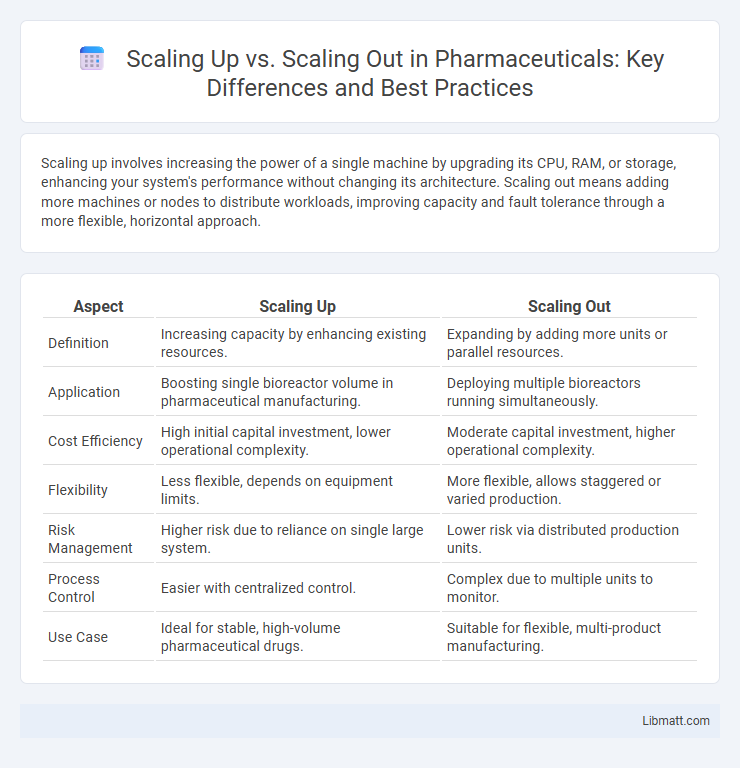Scaling up involves increasing the power of a single machine by upgrading its CPU, RAM, or storage, enhancing your system's performance without changing its architecture. Scaling out means adding more machines or nodes to distribute workloads, improving capacity and fault tolerance through a more flexible, horizontal approach.
Table of Comparison
| Aspect | Scaling Up | Scaling Out |
|---|---|---|
| Definition | Increasing capacity by enhancing existing resources. | Expanding by adding more units or parallel resources. |
| Application | Boosting single bioreactor volume in pharmaceutical manufacturing. | Deploying multiple bioreactors running simultaneously. |
| Cost Efficiency | High initial capital investment, lower operational complexity. | Moderate capital investment, higher operational complexity. |
| Flexibility | Less flexible, depends on equipment limits. | More flexible, allows staggered or varied production. |
| Risk Management | Higher risk due to reliance on single large system. | Lower risk via distributed production units. |
| Process Control | Easier with centralized control. | Complex due to multiple units to monitor. |
| Use Case | Ideal for stable, high-volume pharmaceutical drugs. | Suitable for flexible, multi-product manufacturing. |
Introduction to Scaling Up and Scaling Out
Scaling up refers to enhancing the capacity of a single server or system by adding more resources such as CPU, RAM, or storage to improve performance. Scaling out involves increasing capacity by adding more servers or nodes to a distributed system, enabling better load distribution and fault tolerance. Both strategies are essential for optimizing system performance and accommodating growing workloads in cloud computing and data center environments.
Defining Scaling Up: What Does It Mean?
Scaling up refers to increasing the capacity of a single server or resource by adding more CPU, RAM, or storage to handle higher workloads. This vertical scaling approach enhances performance without changing the system architecture, making it ideal for applications requiring powerful single-node processing. Your infrastructure benefits from simplified management and reduced latency when scaling up, but it may face limitations due to hardware constraints.
Defining Scaling Out: Core Concepts
Scaling out involves adding more individual nodes or machines to a system to handle increased workloads, rather than upgrading the capacity of a single node. This approach improves fault tolerance and load distribution by distributing tasks across multiple servers or instances. Your infrastructure benefits from enhanced flexibility and resilience, as scaling out allows seamless expansion without the limitations of hardware upgrades on a single machine.
Key Differences Between Scaling Up and Scaling Out
Scaling up involves enhancing the capacity of a single server or machine by adding more resources like CPU, RAM, or storage, whereas scaling out distributes the workload across multiple machines or servers to handle increased demand. Key differences include scalability limits, with scaling up constrained by the physical limits of a single machine, while scaling out offers virtually unlimited growth by adding more nodes. Cost implications also vary as scaling up typically incurs higher expense per unit, but scaling out may require complex management and networking overhead.
When to Choose Scaling Up Over Scaling Out
Choose scaling up when your application requires high-performance computing with fewer nodes, such as intensive database operations or workloads needing strong consistency. It is ideal if your infrastructure budget favors investing in more powerful servers instead of managing numerous machines. Your decision should consider scaling up when simplicity and lower latency outweigh the benefits of horizontal distribution.
Advantages of Scaling Up
Scaling up enhances your system's performance by upgrading existing hardware, such as adding more CPU power, memory, or faster storage, which reduces latency and simplifies management. It offers better consistency and reliability by utilizing powerful, centralized resources without the complexity of distributed systems. This approach minimizes downtime and maintenance effort, making it ideal for applications requiring high single-node performance and straightforward infrastructure.
Advantages of Scaling Out
Scaling out offers enhanced fault tolerance by distributing workloads across multiple servers, reducing the risk of a single point of failure. It provides greater flexibility and cost-efficiency, as resources can be added incrementally to match demand without major infrastructure changes. Your application benefits from improved performance and scalability, especially in cloud environments where horizontal scaling aligns with dynamic, distributed architectures.
Challenges and Limitations of Each Approach
Scaling up faces challenges such as hardware limitations, high costs of powerful servers, and potential single points of failure that impact system reliability. Scaling out encounters limitations in managing distributed systems, including data consistency, network latency, and increased complexity in coordination and maintenance. Both approaches require careful consideration of workload characteristics and scalability needs to optimize performance and cost efficiency.
Use Cases: Real-world Examples of Scaling
Scaling up involves increasing the capacity of a single server or resource, commonly applied in database management systems handling large transactions, such as financial institutions upgrading to high-performance servers to improve processing speed. Scaling out, often used in cloud computing, adds multiple machines to distribute workloads, exemplified by social media platforms like Facebook expanding their server clusters to handle millions of simultaneous user interactions. Your choice depends on the specific use case, with scaling up preferred for resource-intensive applications requiring powerful hardware, and scaling out suited for systems emphasizing high availability and fault tolerance.
Conclusion: Making the Right Scaling Decision
Choosing between scaling up and scaling out depends on your application's architecture, workload demands, and budget constraints. Scaling up enhances performance by increasing resources on a single server, ideal for monolithic applications, while scaling out improves redundancy and load distribution through multiple servers. Your optimal scaling decision balances cost efficiency, system reliability, and future growth potential to ensure seamless performance under varying loads.
Scaling up vs Scaling out Infographic

 libmatt.com
libmatt.com